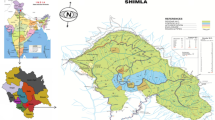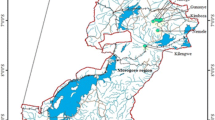Abstract
To understand the impacts of reforestation on woody species composition, species diversity and community structure, seven plantation forests in dry-hot valley of the Jinsha River in Southwest China were investigated, with adjacent wastelands, natural shrub grassland and a natural forest as references. Species importance value, species richness, species heterogeneity and Sorenson similarity index between plantations and the natural forest were analyzed. Results indicated that compared to wastelands and natural shrub grassland, reforestation improved species diversity and community structure, and more forest woody species found suitable habitats in plantations. Species diversity in understory of plantations and Sorenson similarity index were significantly negatively correlated with stem density in mature plantations (26-31 years old). Higher species diversity and Sorenson similarity index existed in mature sparse plantations due to lower stem density and more tree species planted initially. In contrast, reference natural forest, with species heterogeneity of 2.28 for shrub layer, showed the highest species diversity. It would take a long time for species composition and diversity to recover through reforestation in a dry-hot valley. Therefore, it was essential to protect remnant natural forests strictly and reforest with suitable management such as lower stem density and increasing genetic diversity of trees planted.
Similar content being viewed by others
References
Alrababah MA, Alhamad MA, Suwaileh A, et al. (2007) Biodiversity of semi-arid Mediterranean grasslands: Impact of grazing and afforestation. Applied Vegetation Science 10(2): 257–264. DOl: 10.1111/j.1654-109X.2007.tb00524.x
Andres C, Ojeda F (2002) Effects of afforestation with pines on woody plant diversity of Mediterranean heathlands in southern Spain. Biodiversity and Conservation 11(9): 1511–1520. DOI: 10.1023/A:1016850708890
Balvanera P, Pfisterer AB, Buchmann N, et al. (2006) Quantifying the evidence for biodiversity effects on ecosystem functioning and services. Ecology Letters 9(10): 1146–1156. DOI: 10.1111/j.1461-0248.2006.00963.x
Barbour MG, Pitts WD, Burk JH (1980) Terrestrial Plant Ecology. Cummings Publishing Company. pp 130–236.
Brockerhoff EG, Ecroyd CE, Leckie AC, et al. (2003) Diversity and succession of adventive and indigenous vascular understory plants in Pinus radiata plantation forests in New Zealand. Forest Ecology and Management 185(3): 307–326. DOl: 10.1016/S0378-1127(03)00227-5
Brosofske KD, Chen J, Crow TR (2001) Understory vegetation and site factors: implications for a managed Wisconsin landscape. Forest Ecology and Management 146(1): 75–87. DOI: 10.1016/S0378-1127(00)0047-3
Chapin FS, Walker BH, Hobbs RJ, et al. (1997) Biotic control over the functioning of ecosystems. Science 277(5325): 500–504. DOI: 10.1126/science.277.5325.500
Chazdon RL, Fetcher N (1984) Photosynthetic light environments in a lowland of tropical rain forest in Costa Rica. Journal of Ecology 72(2): 553–564. DOI: 10.2307/2260066
Costa JN, Durigan G (2010) Leucaena leucocephala (Lam.) de Wit (Fabaceae): invasive or ruderal? Revista Árvore 34(5): 825–833. DOI: 10.1590/s0100-67622010000500008 (In Portuguese)
Curtis JT, McIntosh RP (1951) An upland forest continuum in the prairie-forest border region of Wisconsin. Ecology 32(3): 476–496. DOl: 10.2307/1931725
DeWalt SJ, Maliakal SK, Denslow JS (2003) Changes in vegetation structure and composition along a tropical forest chronosequence: implications for wildlife. Forest Ecology and Management 182(1): 139–151. DOI: 10.1016/S0378-1127(03)00029-X
Fang HD, Ji ZH, Yang YX, et al. (2005) The study on species diversity of Leucaena leucocephala plantation in Jinsha River hot and dry valley. Research of Soil and Water Conservation 12(1): 135–137. (In Chinese)
Fang W, Peng SL (1997) Development of species diversity in the restoration process of establishing a tropical man-made forest ecosystem in China. Forest Ecology and Management 99(1): 185–196. DOI: 10.1016/S0378-1127(97)00204-1
Felix KK, Claire HQ, Andrew JD, et al. (2013) Floristic composition, species diversity and carbon storage in charcoal and agriculture fallows and management implications in Miombo woodlands of Zambia. Forest Ecology and Management 304: 99–109. DOI: 10.1016/j.foreco.2013.04.024
Givnish TJ (1999) On the causes of gradients in tropical tree diversity. Journal of Ecology 87(2): 193–210. DOI: 10.1046/j.1365-2745.1999.00333.x
Guo ZH, Zang RG, Jiang YX (2002) The formation and maintenance mechanisms of biodiversity and the research techniques for biodiversity. Scientia Silvae Sinicae 38(6): 116–124. (In Chinese)
Hacker SD, Gaines SD (1997) Some implications of direct positive interactions for community species diversity. Ecology 78(7): 1990–2003.
Holmes PM (2001) Shrubland restoration following woody alien invasion and mining: effects of topsoil depth, seed source, and fertilizer addition. Restoration Ecology 9(1): 71–84. DOI: 10.1046/j.1526-100x.2001.009001071.x
Hooper E, Condit R, Legendre P (2002) Responses of 20 native tree species to reforestation strategies for abandoned farmland in Panama. Ecological Applications 12(6): 1626–1641. DOI: 10.2307/3099927
Hubbell SP, Foster RB, O'Brein ST, et al. (1999) Light-gap disturbances, recruitment limitation, and tree diversity in a neotropical forest. Science 283(5401): 554–557. DOI: 10.1126/science.283.5401.554
Jacobs M, Kruk R, Oldeman RAA (1988) The Tropical Rain Forest: A First Encounter. Springer-Verlag. p 295.
Jactel H, Brockerhoff EG (2007) Tree diversity reduces herbivory by forest insects. Ecology Letters 10(9): 835–848. DOI: 10.1111/j.1461-0248.2007.01073.x
Jakel A, Roth M (2004) Conversion of single-layered Scots pine monocultures into close-to-nature mixed hardwood forests: effects on parasitoid wasps as pest antagonists. European Journal of Forest Research 123(3): 203–212. DOI: 10.1007/s10342-004-0030-x
Jiang YX (1991) Jianfengling Tropical Forest Ecosystem in Hainan, China. Science Press. pp 20–130. (In Chinese)
Jones ER, Wishnie MH, Deago J, et al. (2004) Facilitating natural regeneration in Saccharum spontaneum (L.) grasslands within the Panama Canal Watershed: effects of tree species and tree structure on vegetation recruitment patterns. Forest Ecology and Management 191(1): 171–183. DOI: 10.1016/j.foreco.2003.12.002
Kalaba FK, Quinn CH, Dougill AJ, et al. (2013) Floristic composition, species diversity and carbon storage in charcoal and agriculture fallows and management implications in Miombo woodlands of Zambia. Forest Ecology and Management 304: 99–109. DOI: 10.1016/j.Foreco.2013.04.024
Langer ER, Steward GA, Kimberley MO (2008) Vegetation structure, composition and effect of pine plantation harvesting on riparian buffers in New Zealand. Forest Ecology and Management 256(5): 949–957.
Lemma B, Kleja DB, Nilsson I, et al. (2006) Soil carbon sequestration under different exotic tree species in the southwestern highlands of Ethiopia. Geoderma 136(3): 886–898. DOI: 10.1016/j.geoderma.2006.06.008
Lin YM, Cui P, Wang DJ, et al. (2009) Community characteristic of plantation of Leucaena leucocephala in the area with high-frequency debris flow. Science of Soil and Water Conservation 7(6): 63–67. (In Chinese)
Liu FY, Li K, Ma JM (2008) Ecological study on several man-made forests of introduced species in Jinshajiang dry-hot valley. Resources and Environment in the Yangtze Basin 17(3): 468–474. (In Chinese)
Liu FY, Wang XQ, Li K, et al. (2012) Species composition and diversity characteristics of Quercus franchetii communities in dry-hot valley of Jinsha River. Guihaia 32(1): 56–62. DOI: 10.3969/J.issn.1000-3142.2012.01.03 (In Chinese)
Lu RK (2000) Analytical Methods of Soil Agrochemistry. China Agricultural Science and Technology Press. pp 106–290. (In Chinese)
Lugo AE (1997) The apparent paradox of reestablishing species richness on degraded lands with tree monocultures. Forest Ecology and Management 99(1): 9–19. DOI: 10.1016/S0378-1127(97)00191-6
Ma JM, Li K, Zhang CS (2006) Regeneration of Acacia glauca and Leucaena leucacephala plantations in Yuanmou dry and hot valley. Chinese Journal of Applied Ecology 17(8): 1365–1369. DOI: 10.13287/j.1001-9332.2006.0271 (In Chinese)
McNeely JA (2003) Biodiversity in arid regions: values and perceptions. Journal of Arid Environments 54(1): 61–70. DOl: 10.1006/jare.2001.0890
Meier AJ, Bratton SP, Duffy DC (1995) Possible ecological mechanisms for loss of vernal-herb diversity in logged eastern deciduous forests. Ecological Applications 5(4): 935–946. DOI: 10.2307/2269344
Meng JH, Lu YC, Lei XD, et al. (2011) Structure and floristics of tropical forests and their implications for restoration of degraded forests of China’s Hainan Island. Tropical Ecology 52(2): 177–191.
Peng SL, Chen AQ, Fang HD, et al. (2013) Effects of vegetation restoration types on soil quality in Yuanmou dry-hot valley, China. Soil Science and Plant Nutrition 59(3): 347–360. DOI: 10.1080/00380768.2013.785918
Ruiz-Jaen MC, Aide TM (2005) Vegetation structure, species diversity, and ecosystem processes as measures of restoration success. Forest Ecology and Management 218(1): 159–173. DOI: 10.1016/j.foreco.2005.07.008
Shannon CE, Weaver W (1963) The Mathematical Theory of Communication. University of Illinios Press. p 117.
Sharma CM, Baduni NP, Gairola S, et al. (2010) Tree diversity and carbon stocks of some major forest types of Garhwal Himalaya, India. Forest Ecology and Management 260(12): 2170–2179. DOI: 10.1016/j.foreco. 2010.09.014
Tang GY, Li K (2013) Tree species controls on soil carbon sequestration and carbon stability following 20 years of afforestation in a valley-type savanna. Forest Ecology and Management 291: 13–19. DOI: 10.1016/j.foreco.2012.12.001
Tang Y, Xie JS, Sun H (2004) Revisiting sustainable development of dry valleys in Hengduan Mountains Region. Journal of Mountain Science 1(1): 38–45. DOI: 10.1007/ BF02919358
Whittaker RH (1972) Evolution and measurement of species diversity. Taxon 21(2/3): 213-251. DOI: 10.2307/1218190
Yang Z, Xiong DH, Zhou HY, et al. (2003) Precipitation infiltration and tree growth on different soil type slope in dry-hot valley. Science in China (Series E) 33(z1): 85–93. (In Chinese)
Zhang XA, Zhao L, Kang L (2001) Evolutionary mechanisms of species coexistence in ecological communities. Biodiversity Science 9(1): 8–17. (In Chinese)
Zhang KR, Dang HS, Tan SD, et al. (2010) Vegetation community and soil characteristics of abandoned agricultural land and pine plantation in the Qinling Mountains, China. Forest Ecology and Management 259(10): 2036–2047. DOI: 10.1016/j.foreco.2010.02.014
Zhang RZ (1992) The Dry Valleys of the Hengduan Mountains Region. Science Press. pp 10–121. (In Chinese)
Zhong XH (2000) Degradation of ecosystem and ways of its rehabilitation and reconstruction in dry and hot valley. Resources and Environment in the Yangtze Basin 9(3): 376–383. (In Chinese)
Zeugin F, Potvin C, Jansa J, et al. (2010) Is tree diversity an important driver for phosphorus and nitrogen acquisition of a young tropical plantation? Forest Ecology and Management 260(9): 1424–1433. DOI: 10.1016/j.foreco.2010.07.020
Acknowledgments
This study is supported financially by the Program of Introducing Talents of Discipline to Universities (B08037). We thank the Bureau of Forestry of Ningnan County, Sichuan Province, China for support in field work.
Author information
Authors and Affiliations
Corresponding author
Additional information
http://orcid.org/0000-0001-9945-0340
http://orcid.org/0000-0001-7552-4181
Electronic supplementary material
11629_2015_3449_MOESM1_ESM.pdf
Impacts of reforestation on woody species composition, species diversity and community structure in dry-hot valley of the Jinsha River, southwestern China
Rights and permissions
About this article
Cite this article
Gong, Zl., Tang, Y. Impacts of reforestation on woody species composition, species diversity and community structure in dry-hot valley of the Jinsha River, southwestern China. J. Mt. Sci. 13, 2182–2191 (2016). https://doi.org/10.1007/s11629-015-3449-2
Received:
Revised:
Accepted:
Published:
Issue Date:
DOI: https://doi.org/10.1007/s11629-015-3449-2




